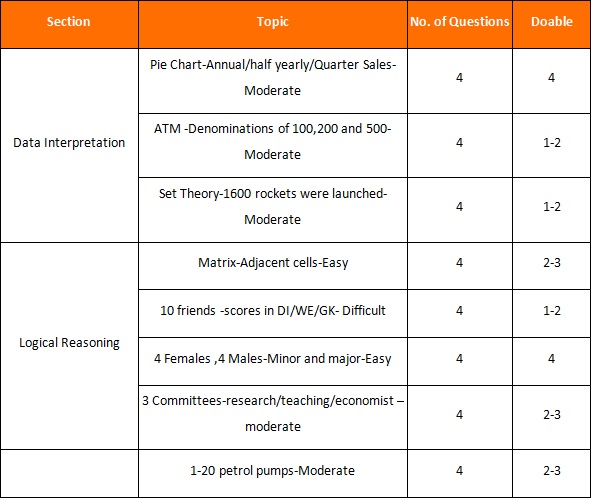
CAT 2018 came out of the bag with two thuds and a loud bang. The paper started with an ‘even easier than 2017’ Verbal Ability and Reading Comprehension (VARC) section. Then the level of difficulty of the Data Interpretation and Logical Reasoning (DILR) section provided a major reprieve to the nervous ‘jantaa’ as it broke from the trend of the last three years. It was a moderately difficult section as compared to an out and out difficult section that has been observed over the last 2-3 years. However, this relief was short-lived as the Quantitative Ability (QA) section came out all guns blazing. IIM-C kept its reputation intact with its emphasis on the QA section. So the break-up of the paper was as follows:

Now let’s take a look at the three sections individually.
Verbal ability and reading comprehension
VA&RC greeted students with an easier than expected paper. However, the pattern of the paper didn’t strictly match that of the sample paper provided by the CAT team. There were 34 questions in total with seven Non-MCQ questions. There were no instructions provided for the number of questions in each passage. However, there remained five passages. One passage had four questions (the passage on Genetics) while the rest had five questions each. The topics of the remaining RC passages were also from familiar areas. They were easy to read. There were quite a few inference-based questions, but these were easy to attempt. The options were not really very close. Only 4-5 questions from RC were tricky. However, a student should have followed the POE (process of elimination) to be able to achieve a decent accuracy rate as the options were not straightforward. The VA section had a major change as compared to previous years. There were four subjective para jumble questions, and all of these had four sentences each. There were three odd sentence para-jumble questions. These questions were easier than expected. A student could have easily managed to get four questions correct out of the seven para jumbles. These were TITA questions. The three summary questions were difficult. The paragraphs focused entirely on research methodology and academic concepts. So, they were difficult to read and comprehend. However, the options were not really difficult. So a voracious reader would have been able to attempt these easily. So, for many CAT aspirants this year (especially those who relied heavily on QA), VA turned out to be a saviour.

Pleasant surprise: The para jumble questions were easy, and the sentences were really short.
Data interpretation and logical reasoning
The next section was DILR. After three consecutive tragedies, DILR-2018 must have been a pleasant surprise. There were 32 questions in total with eight Non-MCQ questions. Unlike last year’s paper, the theme of the sets was more conventional. With smart selection, around four sets in the section could have been attempted very easily with good accuracy. A couple of sets had one ‘difficult to crack’ question each. And a student should have been wise enough to leave these aside. Calculation wasn’t required at all in the DI sets. On the other hand, the LR sets were easy-moderate in terms of level of difficulty.

Overall, 15-17 attempts with accuracy of 90 percent would be considered good.
Quantitative aptitude
At the end, came the real star of the show, the ‘infamous IIM-C QA’. For students who were already terrified of this section, it could have felt like a nuclear disaster. However, for the ‘engineering-dominated’ group, this was not impossible to attempt. The questions were calculation and logic intensive, not theory intensive. There were 34 questions of QA with 12 Non-MCQ questions. It was arguably the toughest QA section in the last four years. The questions were designed to test the grasp of basic fundamentals of the concepts. Arithmetic and Geometry questions dominated the section. In some of the MCQs, options were very confusing to get the right answer. Number System and Logarithm each had at least two questions.

An overall attempt of 18-20 with 85 percent accuracy would be very good.
 Overall, a 99 percentile score could reduce by about 15-18 marks as compared to last year. Thus, a score of 150-155 should fetch a 99 percentile.
Overall, a 99 percentile score could reduce by about 15-18 marks as compared to last year. Thus, a score of 150-155 should fetch a 99 percentile.
Please Note: All information on analysis and scores are based on the accuracy of attempts provided by the candidates as well as independent analysis and evaluation made by the Career Launcher Academic Team. We do not take responsibility for any decision that might be taken, based on this information.
CL extends its best wishes to all CAT aspirants.
The above article is authored by Gautam Bawa, group product head, Career Launcher.


























